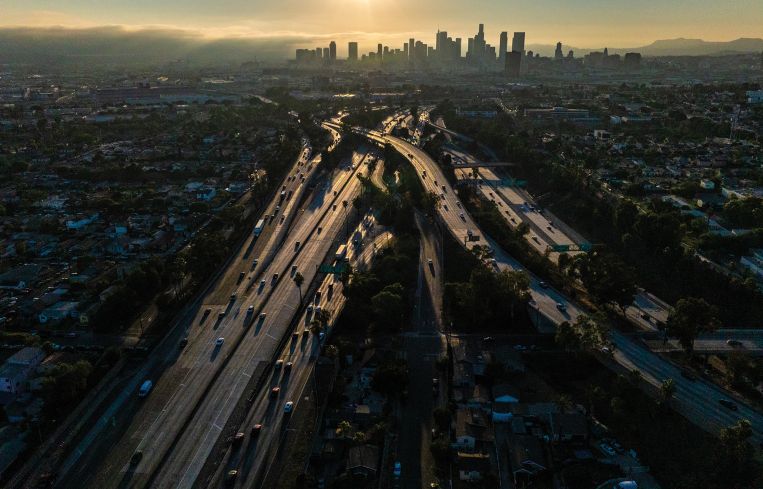L.A. Office Market Shifts Create More Opportunities for a Certain Investor
Longer holds and greater risk create a fertile market for private capital in particular
By Patrick Sisson September 16, 2025 9:00 am
reprints
The distress in Los Angeles’ office market stands out as clearly as the graffiti-scrawled signatures adorning the exterior of downtown’s Oceanwide Plaza.
But a recalibrated regional market — slowly working through financing hurdles, but more primed for deals than it’s been in years — offers new opportunities for less risk-averse buyers with long-term plays in mind, even downtown. It’s not so much a changing of the guard as a better chance for smaller players to buy in.
In just the first half of the year alone, there were $1.8 billion in office investment sales across L.A., according to data from Newmark, and second-quarter volume was twice what it was the same period last year.
Many factors have contributed to this new market reality at a time when office vacancy across SoCal offices remains stubbornly high at 25 percent, according to Newmark. In the same way L.A.’s cultural map is a multifaceted quilt covering much of Southern California, the office market is a puzzle of radically different submarkets, from surging Century City to the still-ailing downtown. And, in the half-decade since the pandemic started, a series of shifts have transformed some Class A offices from portfolio holds to priced-to-move. Hybrid and remote work dampened occupancy and demand, sinking rents and revenue as a result, and a series of high-profile sales have created a new set of comps.
Newmark estimates 47 percent of Los Angeles’ office inventory is “economically unviable” and can’t service its debt. Downtown L.A. has 54 office buildings at immediate risk of devaluation, according to real estate consultancy BAE Urban Economics.
Values for properties in the Financial District and Bunker Hill have dropped 20 to 30 percent, said Sonnet Hui, managing director at Project Management Advisors, with prices in the Market District and Fashion District plummeting 30 to 40 percent from pre-pandemic highs. That’s a block of distressed property that’s only going to grow.
“Properties have fallen so much you’re getting a new batch of investors,” said Hui. “There is always a lot of capital, but the capital is a little more picky right now. It’s high-value in good locations. You’re not seeing your random, more frivolous, trendy, what we call screen-door replacement projects.”
Others also sense opportunities amid the distress.
“I don’t see it as cautious, I see it as an opportunistic market,” said Jeff Bramson, a JLL senior managing director and co-head of its Los Angeles office. “The outlook is cloudy. Nobody knows what’s going to happen, which is why people are buying. You get good value during uncertainty.”
To Dain Fedora, Newmark’s Southwest head of research, transactions such as AON Center, the $80 million purchase of Union Bank Plaza last October and L.A. County’s $200 million pickup of the Gas Company Tower don’t tell the full story when it comes to comparables and a narrative of winners and losers. It’s more a story of dichotomies than distress.
The more important driver today is private capital, Fedora said. With a bigger appetite for both risk and long-term holds, private investors are more perfectly positioned to pick up the coming string of distressed properties seeking a sale, as institutional players, who have much easier markets to underwrite, are more hesitant to invest.
Harbor Associates Principal Joon Choi, whose firm has transacted for a few L.A. properties recently, including 1640 Sepulveda for $45 million back at the end of 2023 and $120 million for a pair of Pasadena office towers in August, said he’s seeing debt providers find their way back to the office market in a meaningful way. There are many more active banks and debt funds than there were a few years ago. And while the transaction volume downtown is far from recovered, Choi said he is seeing capital looking for distress.
“I think there’s going to be a lot more interest with debt becoming more and more available, and we’re pretty encouraged,” he said. “I think a lot of the challenges in the office market for the last several years have been a big question mark about debt.”
There’s still some good building stock available downtown, said Hui, and with recent regulatory changes to downtown that make more areas open for residential conversion as of right, it creates a big sales incentive.
Take the AON Center, which sold in late 2023 and kick-started this market readjustment. Private equity investor Carolwood picked it up for the bargain price of $148 million, below debt costs, and can now offer very competitive rents to tenants. (Carolwood also almost grabbed the EY Plaza in August at another significant price cut before the deal fizzled out.) Uncommon Developers picked up a 52-story tower called Figueroa at Wilshire for $210 million this past June, a fraction of the $700 per foot it commanded during its peak.
“If the investor’s strategy is to hold for the long term, then I think they’re going to be in a great position,” Fedora said. “If their strategy is to hold for three to five years and stabilize and flip, then that’s not going to work under this scenario.”
In true Hollywood fashion, the shift can be seen as just another highly touted but ultimately playbook sequel, argued JLL’s Bramson. The city has long been a private capital market, but institutional investors moved in during the pre-COVID office boom. Since they’ve been losing so much in recent years, many have shunned the submarket. Alternately, local private investors, as well as foreign investors with U.S.-denominated investments looking to preserve capital, see an opportunity to place a good bet.
“It’s a typical cycle,” Bramson said. “Who comes in first? It’s the private capital who have longer hold periods, are not managing for a promoted return, and therefore can be more flexible. Their capital is better aligned to the market that we’re experiencing.
“It’s hard to write an investment committee memorandum today that says everything in Downtown L.A. is going to be great in five years,” he added.
But that doesn’t mean it won’t improve. Fedora has tracked increased activity during the third quarter in Downtown Los Angeles. He also notes that while the city’s dominant entertainment industry has been struggling — a huge weight on local office activity — he thinks recent policy moves, such as Gov. Gavin Newsom’s extension of California’s entertainment industry tax credit program, will start to reinvigorate the field and, in turn, office demand. Bramson added he’s already hearing about production ramping up, and he foresees a media and entertainment bump from artificial intelligence.
“Entertainment is 13 percent of our economy, so once that kicks in, we’ll be in good shape,” he said.
And a slow recovery may benefit some of these new buyers. Choi said some of his winning bids came about in a landscape with fewer challengers, as proven institutional buyers continue to shy away. Going forward, as additional debt and equity investors start digging more into office, the market will get more competitive.


